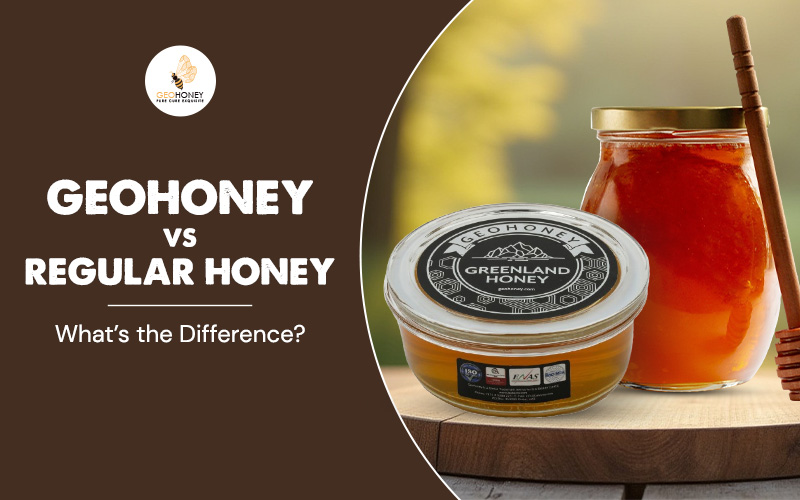- Tokyo: 17:43
- Singapore: 16:43
- Dubai: 12:43
- London: 08:43
- New York: 03:43
GeoHoney vs Regular Honey – What’s the Difference?

True honey enthusiasts know very well that not all honey is the same in terms of flavor, purity, and quality. The way the honey is harvested, processed, and packaged affects its taste, texture, and culinary uses to a great extent.
This is why, instead of buying regular honey that is highly pasteurized or processed, you need to look for quality brands that guarantee minimal processing and high purity. And this is what Geohoney is all about.
This is what the CEO of B A Barry Group and the founder of Geohoney, Mr Basem Barry, says,
“We at Geohoney always strive to deliver 100% raw and natural organic honey while also championing sustainable pollination, greentech technology, and bee conservation at the same time.”
In this blog, we will cover what makes Geohoney different from regular store-bought honey. So, keep on reading till the end.
GeoHoney: A Global Leader in the Raw Honey Industry
Regular Honey: What Do We Mean by It?
Geohoney vs Regular Honey: Key Differences
Floral Sources
Processing
Flavor
Nutritional Value
Certifications and Label Transparency
Shelf Life
GeoHoney: A Global Leader in the Raw Honey Industry
Established in 2017, Geohoney is the leading raw honey brand that provides exceptional monofloral honey products to its consumers worldwide. We have partnered with beekeepers from 158 farms from over 53 countries to bring you more than 367 distinct monofloral honey varieties.
Here is what makes Geohoney stand out.
The honey production processes at Geohoney are aimed at achieving 100% purity while also preserving the health of the bees and the planet.
Our honey is not pasteurized, and it is minimally processed to make sure its original flavor and nutritional components stay intact.
Geohoney uses agritech innovations and high-tech monofloral hives to increase honey yields by up to 20 times without hurting bees or impacting the environment.
Geohoney is on a mission to capture 18% of the global honey market and more than 50% of the global rare honey market by adding 10 new farms to its operations in every quarter.
With these efforts, it plans to make raw, monofloral honey a common household commodity that is accessible to everyone everywhere.
Regular Honey: What Do We Mean by It?
The term regular honey is used for honey products you might find in local stores or online platforms. These generic honey products lack purity, traceability, and nutritional value.
Unlike Geohoney products, regular honey is made from polyfloral or blended sources, and it is highly processed to get a smooth consistency and longer shelf life. These honey products do not have floral source, geographical, or harvest condition labels, which makes their production processes and authenticity highly questionable.
Here are some main features of regular honey.
This is made from mixed nectar sources, which gives it a general flavor profile that lacks distinctness.
This honey is pasteurized, filtered, and ultrafiltered, which gives it a smooth consistency, golden color, and slow crystallization rate.
The pasteurization of regular honey reduces its antioxidant, enzyme, and pollen contents.
This honey may be adulterated with artificial sweeteners to enhance its flavor.
The nutritional value of regular honey is much less than Geohoney due to its high processing.
Geohoney vs Regular Honey: Key Differences
The following are some points that illustrate the key differences between the honey you get from generic brands and Geohoney. So, keep on reading to learn more.
Floral Sources
With regular honey, the labels often show vague or generalized floral sources. These polyfloral or mixed source honey varieties have a generic sweet taste that lacks distinct features.
On the other hand, Geohoney uses special floral sources by carefully controlling the forage behaviors of the bees. This allows us to create over 350 exotic and rare honey varieties, each with a different flavor, aroma, and nutritional profile.
Processing
Regular honey is heated at high temperatures in a process called pasteurization. Apart from that, this honey also undergoes ultrafiltration, which removes bee pollen, propolis, etc.
The excessive heating of general honey destroys enzymes and other bioactive components, lowering the honey quality and nutritional value to a great extent.
On the other hand, Geohoney’s honey products undergo mild heating and minimal filtration. The honey you get is unpasteurized, which allows it to retain its original flavor as well as enzyme, pollen, and propolis content.
Flavor
Regular honey possesses an extra-sweet flavor that lacks distinct features. But with Geohoney, you get a different flavor from each jar of honey based on the floral origins.
This honey has a complex, rich, and more intense flavor that contains fruity, woody, bitter, or smoky notes.
Nutritional Value
Geohoney gives you minimally processed honey that is rich in antioxidants like flavonoids, vitamin A, B, C, and E, minerals like magnesium, potassium, iron, and zinc, and healthy enzymes. This honey also contains pollen, which is another nutrient-rich substance.
But in regular honey, all of these nutritional components are present in little amounts, which means it can only serve you as a sweetener and not as something to enhance your physical or mental wellbeing.
Certifications and Label Transparency
Regular honey often lacks label transparency and quality certifications when it comes to its geographical origin, floral source, processing standards, etc. This means you can never be sure whether this honey is authentic or pure.
Geohoney uses certified tests, and it possesses labels like ISO 9001:2015, HACCP, ENAS, ilac, which ensure every batch of honey is as pure as can be. The robust traceability policy of Geohoney ensures you know the exact origin of every spoonful of monofloral honey you eat.
Shelf Life
Geohoney tends to crystallize faster than regular honey. The slight cloudiness or granulation of this honey results from the presence of pollen, propolis, beeswax, and natural sugars. However, crystallization doesn’t mean spoilage. You can return this honey to its normal form by lightly heating it.
The heavy processing of regular honey makes it crystallize very slowly. By removing crystallization-triggering components during processing, manufacturers extend its shelf life to several years. However, this also leads to a reduction in the therapeutic effects of this honey.
Conclusion
When buying honey for regular or medicinal use, it is always a great idea to pick a reliable source. Unlike regular honey that is highly pasteurized and contains adulterants to increase its sweetness and shelf life, the honey provided by Geohoney gives you 100% purity and maximum health benefits.
Geohoney works with hundreds of local beekeepers from all over the globe to ensure maximum traceability and the best quality.
Our premium raw, monofloral, and wildflower honey is vigorously tested and certified for quality and flavor, which is not something you can get with more processed and less distinctive regular honey. So, if you are looking for honey that gives you an amazing nutritional profile, the best flavor, and 100% authenticity, Geohoney is all you need.
Visit Geohoney today to check out our wide range of monofloral honey products to get 100% purity, top quality, and countless health benefits all in one.



